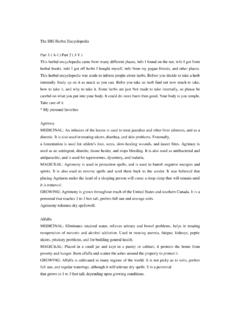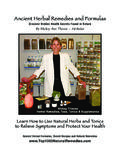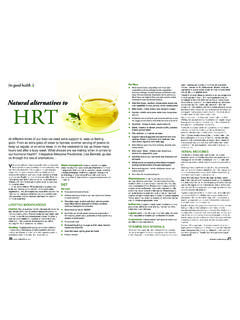Transcription of Germination Instructions for Seeds - Wild Ones
1 Germination Instructions for Seeds The Seeds of many native plants have built-in dormancy mechanisms which protect them from germinating before killing frosts or in times of drought. In the wild, Seeds will lie dormant until the proper conditions for growth occur. But in cultivation, the successful gardener must become familiar with several simple pre-sowing seed treatment methods which will unlock the dormancy mechanism and stimulate quicker, more consistent Germination . The Prairie Moon Nursery has developed the following seed Germination codes to help you successfully grow the native plant Seeds sold in their catalog. These seed treatment suggestions have been compiled from available literature, their own experience, and feedback from other growers and customers.
2 These are only suggestions and not the definitive source of Germination information. If your experience reveals successful methods other than these, please let us know. To find the seed treatment method for the species you are interested in growing, look under the Germination Code column on the Plant List and Germination Codes chart the follows this brief description. Until you are ready to plant or apply pre-sowing treatment, seed should be stored in either a sealed (airtight) container under refrigeration (33-40 F) or in an open container in a cool, dry place. Avoid rapid or frequent temperature changes and protect against rodents. (See further Instructions elsewhere in the chapter guidebook.). Sow Seeds shallowly and keep seedlings carefully weeded.
3 Periodic watering is helpful to establish seedlings. If seed does not germinate the first year, don't give up; Germination may occur the second year or even later. A. No pre-treatment necessary other than cold, dry storage (also called dry cold stratification.). seed should germinate upon sowing in a warm location. B. Hot Water Treatment. Bring water to a boil, remove from stove, pour over seed , soak for 24 hours. Plant or moist cold stratify if needed (code C). C. Seeds germinate after a period of moist, cold stratification. Please note: Do not use this method of you are planting a seed mix and cannot keep the site moist. Also, do not stratify if you are fall planting or using a seed drill. Mix Seeds with equal amounts or more of damp sand, vermiculite, or other sterile media (moist-but not so wet that water will squeeze out of a handful).
4 Prairie Moon Nursery uses silica sand (purchase at a building supply center) for small quantities. For large quantities you can use coarse grade vermiculite. Place mixture in a labeled, sealed plastic bag and store in refrigerator (33-38 F). Two months of this cold storage before planting is normally required to break the dormancy of these Seeds , but one month may work for many species if time is a constraint. Exceptions to length of storage time are noted in Germination Instructions for Seeds page 1. the Cultural Guide in parentheses [Example: C (90) = C for 90 days]. Some Seeds may sprout in the storage bag if moist stratified too long. If sprouting occurs, plant immediately. Another method of breaking dormancy for species requiring moist stratification is to sow Seeds outdoors in the fall so they may overwinter.
5 D. Seeds are very small or need light to naturally break dormancy and germinate. Sow Seeds in a container (pot or flat) and water from the bottom as necessary. seed requiring this treatment should not be covered after sowing, although a light dusting of soil can be applied. If grown in outdoor beds, sow Seeds on level soil. Cover with a single layer of burlap or cotton sheet. Do not let soil dry out until seedlings are established. Remove cover after Germination . Shading with a window screen set 12 . above the soil the first season will help prevent drying. E. In order to germinate, Seeds need a warm, moist period followed by a cold, moist period. Mix Seeds with damp sand (not dripping wet), place in a labeled, sealed plastic bag and store in warm (about 80 F) place for 60-90 days.
6 Then place in refrigerator (33-38 F) for 60-90 days before sowing. Or, sow outdoors and allow one full year for Germination . F. Seeds need a cold, moist period followed by a warm, moist period followed by a 2nd cold, moist period. Seeds germinate after alternating, cold moist, warm moist, cold moist stratification treatments. Start by following Instructions for code C for 60-90 days, then store in warm (70 to 80 degrees F) place for 60-90 days followed by a 2nd cold period. Or sow outdoors and allow 2 years or longer to germinate. G. Seeds germinate most successfully in cool soil. Sow Seeds in late fall (after hard frost) or early spring. H. Seeds need scarification. One way to accomplish this is by rubbing seed between two sheets of medium grit sandpaper.
7 The object is to abrade seed coats - stop if Seeds are being crushed. Scarification should be done before moist, cold stratification (Code C) if this treatment is also needed. seed purchased from Prairie Moon Nursery has been scarified before shipment. Exception: seed , which will be dormant (fall) or frost (winter) seeded outdoors are not scarified to prevent the chance of premature Germination and winter kill. I. Legume, Rhizobium Inoculum. These species are legumes and although they will show satisfactory growth without inoculation we recommend using an inoculum if the proper type is available. The fixation of atmospheric nitrogen improves the long-term health of native plant communities and is especially important in low fertility soils.
8 Prairie Moon Nursery supplies inoculum (when available) at no charge for legume seed purchased from us. J. Prairie Nursery removes the hulls from these legume Seeds . This gives you more Seeds per pound and greatly improves Germination . If you have unhulled seed from another source, treat as in Code H. K. Parasitic species which needs a host plant. Germination Instructions for Seeds page 2. For container growing. Excellent hosts (for many parasitic species) include low-growing grasses and sedges like Hairy Grama, Blue Grama, Buffalo Grass, Pennsylvania Sedge, Sweet Grass, and June Grass. With a knife make a 2 deep cut at the base of the host plant. Sow Seeds in the cut, making sure seed is not more than 1/8 deep. If host is transplanted at sowing time, the cut is not needed because damaged roots will be available for attachments by the parasite.
9 You may also try sowing parasitic and host species Seeds together at the same time. To add parasitic species to existing sites, scatter seed on soil surface (rake in if seed is large) in late fall. L. Plant Fresh seed or keep moist. Refrigerate until planting or starting other treatment. M. Rest fall planted out doors. N. Special seed treatment required. Seeds purchased from a reliable native plant nursery will have already received this treatment. Best planted in spring after soil is warm. O. seed needs nicking. Nick seed coat with knife, soak in water overnight. Plant. P. Fern spore sowing. Sow fern spores on sterile peat under glass in indirect light. Water with distilled water. Refer to other reference material on growing ferns.
10 Or, direct sow spores on soil surface. Printed with permission of Prairie Moon Nursery, Winona, MN Please see Nursery Plant List and Germination Codes Chart which follows. Germination Instructions for Seeds page 3. Nursery Plant List and Germination Codes Common Name Scientific Name Germ. Code Allegheny Serviceberry Amelanchier laevis M or C. American Columbo Frasera caroliniensis E. American Cranberrybush Viburnum trilobum F,Clone American Slough Grass Beckmannia syzigachne A. Amethyst Shooting Star Dodecatheon amethystinum D,G&C/M. Angelica Angelica atropurpurea F. Anise Hyssop Agastache foeniculum C or A,D. Aromatic Aster Aster oblongifolius A. Arrowleaf Sweet Coltsfoot Petasites sagittatus ? Arrow-leaved Aster Aster sagittifolius C,D.








